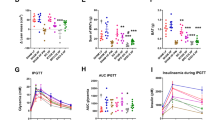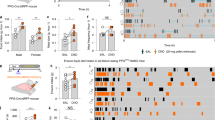Abstract
Objective:
This study was carried out to determine the effects of the biliopancreatic diversion (BPD), a bariatric surgery applied to the treatment of morbidly obese humans, on energy balance in rats.
Methods:
BPD was performed on a group of male Wistar rats. Body weight and food intake were measured daily throughout the study. Feces were also collected to assess energy losses and the determination of digestible energy. Energy expenditure and body composition were also determined for the 50-day length of the protocol. On the day of killing, the brain, the entire intestinal tract and white and brown adipose tissues were collected and weighed. Expression of neuropeptide Y (NPY) and agouti-related protein (AgRP) in the ARC nucleus were assessed by in situ hybridization.
Results:
Marked changes in the regulation of energy balance were observed in the BPD-operated rats. A decrease in digestible energy and food intake coupled with an increase in the fecal energy density and protein fecal energy led to an important weight loss in the BPD-operated rats. This weight loss was observed in the loss of fat mass (specifically the white epididymal, inguinal, retroperitoneal and brown adipose tissues). The rats modified their food intake pattern to be able to potentially eat more during the entire day. An increase in the surfaces of all intestinal structures (muscular and mucosal layers) was observed in the BPD-operated rats. The NPY and AgRP expression in the brain were both shown to be greater in the BPD-operated rats than in the control animals. At the beginning of the study, the surgery led to an energy expenditure decrease, which, however, did not persist throughout the study despite the fact that BPD-operated rats exhibited persistent lower fat free masses.
Conclusion:
BPD led to a noticeable reduction in weight and fat gains in rats, which was in large part owing to a decrease in digestible energy intake led to by the gastrectomy, the intestinal malabsorption inherent to the surgery and to potentially a thermogenesis stimulation that occurred in the second end of the study. The reduction in energy gain occurs despite adaptations to thwart the intestinal malabsorption and the hunger signals from the central nervous system.
This is a preview of subscription content, access via your institution
Access options
Subscribe to this journal
Receive 12 print issues and online access
$259.00 per year
only $21.58 per issue
Buy this article
- Purchase on Springer Link
- Instant access to full article PDF
Prices may be subject to local taxes which are calculated during checkout








Similar content being viewed by others
References
Hedley AA, Ogden CL, Johnson CL, Carroll MD, Curtin LR, Flegal KM . Prevalence of overweight and obesity among US children, adolescents, and adults, 1999–2002. JAMA 2004; 291: 2847–2850.
Lobstein T, Baur L, Uauy R . Obesity in children and young people: a crisis in public health. Obes Rev 2004; 5 (Suppl 1): 4–104.
Despres JP . Health consequences of visceral obesity. Ann Med 2001; 33: 534–541.
Bray GA . Medical consequences of obesity. J Clin Endocrinol Metab 2004; 89: 2583–2589.
Klein S, Burke LE, Bray GA, Blair S, Allison DB, Pi-Sunyer X et al. Clinical implications of obesity with specific focus on cardiovascular disease: a statement for professionals from the American Heart Association Council on Nutrition, Physical Activity, and Metabolism: endorsed by the American College of Cardiology Foundation. Circulation 2004; 110: 2952–2967.
Herron DM . The surgical management of severe obesity. Mt Sinai J Med 2004; 71: 63–71.
Sharma AM . Obesity and cardiovascular risk. Growth Horm IGF Res 2003; 13 (Suppl A): S10–S17.
Scopinaro N, Adami GF, Marinari GM, Gianetta E, Traverso E, Friedman D et al. Biliopancreatic diversion. World J Surg 1998; 22: 936–946.
Marceau P, Hould FS, Potvin M, Lebel S, Biron S . Biliopancreatic diversion (duodenal switch procedure). Eur J Gastroenterol Hepatol 1999; 11: 99–103.
Marceau P, Hould FS, Simard S, Lebel S, Bourque RA, Potvin M et al. Biliopancreatic diversion with duodenal switch. World J Surg 1998; 22: 947–954.
Marceau P, Hould FS, Lebel S, Marceau S, Biron Sn . Malabsorptive obesity surgery. Surg Clin N Amer 2001; 81: 1113.
Hahn TM, Breininger JF, Baskin DG, Schwartz MW . Coexpression of Agrp and NPY in fasting-activated hypothalamic neurons. Nat Neurosci 1998; 1: 271–272.
Morton GJ, Schwartz MW . The NPY/AgRP neuron and energy homeostasis. Int J Obes Relat Metab Disord 2001; 25 (Suppl 5): S56–S62.
Levine AS, Jewett DC, Cleary JP, Kotz CM, Billington CJ . Our journey with neuropeptide Y: effects on ingestive behaviors and energy expenditure. Peptides 2004; 25: 505–510.
Lagace M, Marceau P, Marceau S, Hould FS, Potvin M, Bourque RA et al. Biliopancreatic diversion with a new type of gastrectomy: some previous conclusions revisited. Obes Surg 1995; 5: 411–418.
Simmons DM, Arriza JL, Swanson LW . A complete protocol for in situ hybridization of messenger RNAs in brain and other tissues with radiolabeled single-stranded RNA probes. J Histotechnol 1989; 12: 169–181.
Evrard S, Aprahamian M, Loza E, Guerrico M, Marescaux J, Damge C . Malnutrition and body weight loss after biliopancreatic bypass in the rat. Int J Obes Relat Metab Disord 1991; 15: 51–58.
Evrard S, Hoeltzel A, Aprahamian M, Bernard C, Mutter D, Marescaux J et al. Implication of cholecystokinin in pancreatic adaptation after biliopancreatic bypass in the rat. Digestion 1994; 55: 208–213.
Evrard S, Aprahamian M, Hoeltzel A, Vasilescu M, Marescaux J, Damge C . Trophic and enzymatic adaptation of the intestine to biliopancreatic bypass in the rat. Int J Obes Relat Metab Disord 1993; 17: 541–547.
Scopinaro N, Gianetta E, Civalleri D, Bonalumi U, Bachi V . Bilio-pancreatic bypass for obesity: II. Initial experience in man. Br J Surg 1979; 66: 618–620.
Scopinaro N, Gianetta E, Civalleri D, Bonalumi U, Bachi V . Bilio-pancreatic bypass for obesity: 1. An experimental study in dogs. Br J Surg 1979; 66: 613–617.
Adami GF, Campostano A, Gandolfo P, Marinari G, Bessarione D, Scopinaro N . Body composition and energy expenditure in obese patients prior to and following biliopancreatic diversion for obesity. Eur Surg Res 1996; 28: 295–298.
Zhou J, Yan X, Ryan DH, Harris RB . Sustained effects of repeated restraint stress on muscle and adipocyte metabolism in high-fat-fed rats. Am J Physiol 1999; 277: R757–R766.
Deitel M . Overview of operations for morbid obesity. World J Surg 1998; 22: 913–918.
Scopinaro N, Marinari GM, Pretolesi F, Papadia F, Murelli F, Marini P et al. Energy and nitrogen absorption after biliopancreatic diversion. Obes Surg 2000; 10: 436–441.
Farrell DJ, Williams VJ . Calorimetric measurements made on rats during repeated periods of weight gain and weight loss. Comp Biochem Physiol [A] 1989; 94: 61–67.
Bobbioni-Harsch E, Morel P, Huber O, AssimacopoulosJeannet F, Chassot G, Lehmann T et al. Energy economy hampers body weight loss after gastric bypass. J Clin Endocrinol Metab 2000; 85: 4695–4700.
Strader AD, Vahl TP, Jandacek RJ, Woods SC, D’Alessio DA, Seeley RJ . Weight loss through ileal transposition is accompanied by increased ileal hormone secretion and synthesis in rats. Am J Physiol Endocrinol Metab 2005; 288: E447–E453.
Koopmans HS, Sclafani A, Fichtner C, Aravich PF . The effects of ileal transposition on food intake and body weight loss in VMH-obese rats. Am J Clin Nutr 1982; 35: 284–293.
Patriti A, Facchiano E, Sanna A, Gulla N, Donini A . The enteroinsular axis and the recovery from type 2 diabetes after bariatric surgery. Obes Surg 2004; 14: 840–848.
Author information
Authors and Affiliations
Corresponding author
Rights and permissions
About this article
Cite this article
Nadreau, E., Baraboi, ED., Samson, P. et al. Effects of the biliopancreatic diversion on energy balance in the rat. Int J Obes 30, 419–429 (2006). https://doi.org/10.1038/sj.ijo.0803166
Received:
Revised:
Accepted:
Published:
Issue Date:
DOI: https://doi.org/10.1038/sj.ijo.0803166
Keywords
This article is cited by
-
Consistent gut bacterial and short-chain fatty acid signatures in hypoabsorptive bariatric surgeries correlate with metabolic benefits in rats
International Journal of Obesity (2022)
-
Global transcriptome analysis of rat hypothalamic arcuate nucleus demonstrates reversal of hypothalamic gliosis following surgically and diet induced weight loss
Scientific Reports (2019)
-
Alterations of Gut Microbiota After Biliopancreatic Diversion with Duodenal Switch in Wistar Rats
Obesity Surgery (2019)
-
Longer-Term Physiological and Metabolic Effects of Gastric Bypass Surgery
Current Diabetes Reports (2016)
-
Preserve Common Limb in Duodenal–Jejunal Bypass Surgery Benefits Rats with Type 2-Like Diabetes
Obesity Surgery (2014)



